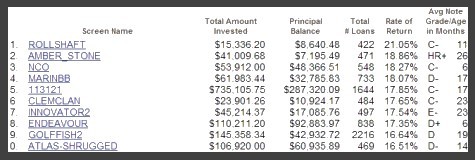For beginners, their first months of lending mostly involve becoming more acquainted with the Lending Club or Prosper platforms and their various terminology. I remember when I was first starting out. Terms like “average weighted rate” meant nothing to me, and sites like NickelSteamroller seemed hard to grasp. But eventually the process got clearer and clearer. Within a few months, I understood the majority of what I saw. Logging in, filtering the platform for available loans, and choosing which to fund became a quick and enjoyable routine.
As I became more familiar with the process, I soon realized that there were some choices I had to make:
- How often should I log in to reinvest my returns?
- How much work should I devote to creating good filters?
- What if a note goes late? Should I hang in there or try to resell it on FOLIOfn?
- Should I try buying notes on FOLIOfn?
- How much time and energy do I have for this whole thing?
This is the tension between active versus passive investing. The reality is that your returns are likely to go up if you have more time to give to them. So today we are going to compare active vs. passive investing approaches through the lens of the Star Wars galaxy. The question is: which character are you? Do you lend more like Luke Skywalker or Han Solo?
Active and Passive Lending: Definition
What do we mean by active and passive investing? Basically, the more passive an investment is, the less involvement it requires. This is the difference between owning a hotel versus a parking lot in downtown Seattle. A hotel takes a dramatic amount of time and energy to maintain, while a parking takes far less. People often prefer a more passive approach to investing because they would rather spend their time elsewhere, for instance, at their job or with their family. Others enjoy more active approaches because of the possibility for lucrative returns.
This tension exists in peer to peer lending as well. Many (if not most) lenders prefer their investments to be passive and do not invest much in the lending process. Many of these people go on to earn a decent return. But others have a little extra energy and interest for peer to peer lending, and have gone on to earn really great returns. Let’s look at this gradient in more detail:

Peer to Peer Lending: From Passive to Active
From most passive to most active, I have associated four levels of investing with a character from the glorious Star Wars universe. (Note: the characters are examined chronologically as they were at the opening of A New Hope. This situation does change. For instance, Luke becomes more active and Han less passive by the fall of the Empire.)
Owen Lars – The PRIME Lender (Most Passive)
 Owen Lars is Luke Skywalker’s uncle. He is a simple moisture farmer on the planet Tatooine. Owen’s greatest concern was not to be disturbed, and he often chides Luke for doing anything out of the ordinary. Owen simply wants things to remain steady, with little to no surprise.
Owen Lars is Luke Skywalker’s uncle. He is a simple moisture farmer on the planet Tatooine. Owen’s greatest concern was not to be disturbed, and he often chides Luke for doing anything out of the ordinary. Owen simply wants things to remain steady, with little to no surprise.
This is like the peer to peer lender who uses Lending Club’s PRIME or Prosper’s PREMIER service. These services are 99% hands off. You simply move a chunk of cash ($25,000 or more) over to the platform and forget about it. The platform automatically chooses your loans and you reap the rewards.
PRIME/PREMIER are perfect examples of the drawback to being a totally passive investor: these accounts typically earn a very consistent return but that return is generally just the platform’s overall average. For instance, Lending Club’s platform currently averages a return of 7%, so you can expect a PRIME account to mirror this figure.
Luke Skywalker – The Average Lender (Mostly Passive)
 The opening of A New Hope finds Luke Skywalker busy with the demands of his job. At the request of his uncle Owen, he is continuously doing the repairs involved with operating machinery on a sandy desert planet like Tatooine. However, he still finds time to explore his boundaries, for instance taking his T16 Skyhopper to shoot womp rats in Beggars Canyon. Within the demands of a busy life, Luke longs for more time to explore.
The opening of A New Hope finds Luke Skywalker busy with the demands of his job. At the request of his uncle Owen, he is continuously doing the repairs involved with operating machinery on a sandy desert planet like Tatooine. However, he still finds time to explore his boundaries, for instance taking his T16 Skyhopper to shoot womp rats in Beggars Canyon. Within the demands of a busy life, Luke longs for more time to explore.
Luke is like the average peer to peer lender, staying mostly passive. This lender has opened a regular account, chooses loans to invest in, remains diversified, and intermittently logs back in to reinvest the collected returns. This level of lending does have some activity, perhaps using filters, but these filters are often very minimal (for instance, not funding loans to people who have had a past bankruptcy).
This lender is happy with their experience, receiving a mildly higher-than-average return. This is the individual that sites like LendingMemo are trying to reach. After all, with just a little work you can get a better return, perhaps becoming more like…
Lando Calrissian – The Educated Lender (Mostly Active)
 Lando is an ex-smuggler who has settled down for a slightly more stable career. We meet him in the second film The Empire Strikes Back. While he does cherish his stability, Lando is also consistently working the system to help administer Cloud City, a mining colony on the gas planet Bespin. He is an excellent leader, sober yet savvy, and enjoys great success as a result of his refined skill.
Lando is an ex-smuggler who has settled down for a slightly more stable career. We meet him in the second film The Empire Strikes Back. While he does cherish his stability, Lando is also consistently working the system to help administer Cloud City, a mining colony on the gas planet Bespin. He is an excellent leader, sober yet savvy, and enjoys great success as a result of his refined skill.
Lando represents the skilled peer to peer lender who has taken a bit of time to better refine his or her practice. For instance, this lender may have developed a better rhythm to log into their account and avoid cash drag by putting uninvested funds to work. The educated peer to peer lender understands tools like NickelSteamroller’s Portfolio Analyzer, and has used them to create solid filters, perhaps even using two or three filters per platform. They may use FOLIOfn to sell a note that has gone late at a loss, so as to avoid a default, and might have both taxable and IRA accounts, perhaps with both Lending Club and Prosper.
While the educated lender certainly values other things in life above peer to peer lending, they have done their homework and receive a higher than average return as a result.
Han Solo – The Savant (Most Active)
 Han Solo is a smuggler who knows the system backwards and forwards. He carefully calculates the risks, often making decisions that push typical boundaries. His ship, the frugal Millinium Falcon, is famous for its great performance within risky situations, completing the something as lucrative as the Kessel Run in only twelve parsecs. Han cherishes his freedom, enjoying the rewards that come from great skill and technique.
Han Solo is a smuggler who knows the system backwards and forwards. He carefully calculates the risks, often making decisions that push typical boundaries. His ship, the frugal Millinium Falcon, is famous for its great performance within risky situations, completing the something as lucrative as the Kessel Run in only twelve parsecs. Han cherishes his freedom, enjoying the rewards that come from great skill and technique.
“Han Solo”-like investors know peer to peer lending’s ins and outs, and often enjoy amazing returns from their investment of time and energy. An educated active lender on Lending Club or Prosper does most (or all) of the following:
- Understands p2p statistical analysis (IE: interested in Sharpe Ratio) to create high-performing portfolios containing little risk
- Knows how to find hard-to-find loans by investing when the platforms are updated with new loans (weekdays at 6am, 10am, 2pm, and 6pm for Lending Club)
- Downloads the Lending Club’s available notes onto Excel for better filtering when investing or uses an API
- Can closely monitor their notes with little effort
- Knows the signs of a note that is about to go late, selling them beforehand on FOLIOfn (deftly avoiding charge-offs)
- Uses FOLIOfn to buy discounted notes that still have a high yield to maturity
These expert investors typically earn the very highest return, sometimes over 15%. Below is a graphic of the top 10 seasoned lenders on Prosper (from Prosper-Stats.com):
Passive vs. Active Lending: A Challenge
One of the main reasons Lending Memo exists is to challenge lenders into stepping up their game. While many lenders (like my friend Jenny) do not have extra time and thus seek the most passive investment possible, there is so much to be gained from becoming better educated. Just a little extra work can mean big returns for your lending experience.
[All Star Wars media (c) Lucasfilm Ltd. under Fair Use.]


Leave a question or comment